Technology enhancing operational effectiveness
The society in which we live was once an agricultural society. The production and care of the crops formed the basis for the economy of this society. Besides agriculture, there are other employment opportunities. But the importance was given only to agriculture. Land cultivation continues to be the main source of wealth for that society.
There was a drastic change in the economy from an agricultural to a manufacturing economy. This in turn completely altered the lifestyle and working style of the people. “Industrial Revolution” is the title given to this change. This revolution has made quite many changes. The changes include the way of the manufacturing process.
In the primitive stage, people did the task of manufacturing using their hands. But after the industrial revolution took place, machines took over the process. Industries attained the power of dominance. It leads to the transformation of society upside down. The industrial revolution has all the credit for introducing innovations in technology.
Britain was the motherland of the Industrial Revolution. It was born during the 18th century. After a course of time, the Industrial Revolution started its journey. First, it visits all over Europe and the United States of America. Soon, it began to travel to all corners of the globe.
There are several factors which catalyzed the birth of the Industrial Revolution. They are mentioned below.
The first cause behind the blossoming of the Industrial Revolution is ‘Capitalism’. There is a need for significant work. Investment not from the side of government but from the side of any individual is necessary. In this way, capitalism becomes a cause for the birth of the industrial revolution.
The effects of European Imperialism remain one of the causes of the advent of the industrial revolution. European imperialism made the colonies supply them with plenty of raw materials. Also, they have created a sizable market for their goods. This enabled the industrial revolution to advance to its next level of success.
The mining of resources played a vital role in making the industrial revolution succeed. For instance, coal. The effects caused by the agricultural revolution are another cause of its birth.
Four industrial revolutions marked the advancements in new technologies and power. This in turn helped to ameliorate the manufacturing process.
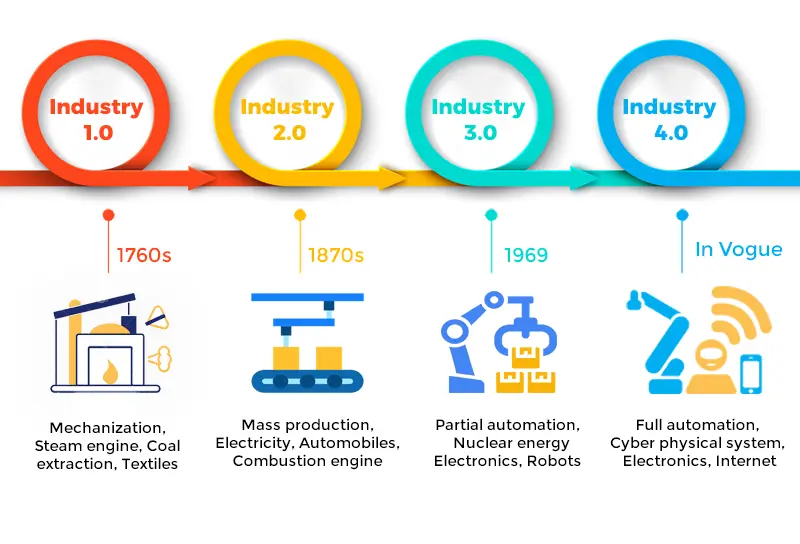
1. First Industrial Revolution
It flourished in the year 1760s. The steam engine made its debut during the first industrial revolution.
Also, the extraction of coal leads to a massive increase in manufacturing processes. It is during this period that mechanization came into the process. Mechanization brings an end to the laboring of human beings and animals. This revolution brings an end to the occurrence of the production process in homes. It also initiated the production process to take place in the ‘factories’ that were specifically built for this purpose.
It not only increased the rate of productivity but also brought changes in both the social and economic worlds. So it got the name “revolution”. This revolution initiated the change in the economy from an agrarian to a manufacturing economy. Before this revolution, the home was the place where they made textiles. Traders used to provide people with the materials needed. Also, they provide the equipment that is obligatory to do the process.
This revolution replaced agriculture with mechanization being the foundation of societal economics.
Notable inventions during the first industrial revolution:
“Steam engine” is the predominant invention. It marked the arrival of new innovative inventions into the world. At first, it was water power that helped to run the mills. Steam power replaced water power. Steam power helped to locate the factories anywhere, not near the water.
“The spinning wheel” is another great invention. This made the process of spinning much easier. Spinning by hand is a time-consuming process. These wheels help to complete the process in a short period and produce a quality product of threads.
2. Second Industrial Revolution
This revolution began in the year 1870.
There was great growth in the economy during the second industrial revolution. Companies and factories started to employ more technological means during this revolution. There was mass production of goods using those new technologies.
An overview of the inventions during this revolution:
Gas, oil, and electricity arrived only during this period of revolution. The engine with internal combustion was also created. The invention of automobiles, as well as planes, helps to transport the product all over the world. This resulted in an increased manufacturing rate.
Communication becomes faster and easier due to the development of the ‘Telegraph’ and ‘Telephone’. There was a rise in demand for steel at the time of the second industrial revolution. Extensive ‘Railroads’ promoted the process of supply of raw materials. By railroads, the manufacture of goods across the world became feasible. They developed Modern production lines. It is a consequence of the birth of ‘Electricity’.
3. Third Industrial Revolution
It got established in the year 1969.
Great technologies emerged in the course of the third industrial revolution. The process of production becomes automated without the entanglement of a human being. Technologies that were once analog are now converted into digital format.
Inventions formed in the digital revolution :
The discovery of “Nuclear” for the first time took place during the revolution. The internet has integrated into our daily lives. Fabrication of the internet was at the time of this revolution. Advancements in telecommunications were there at that time. There was a development in transportation. ‘Robots’ entered the world in this course of time.
This revolution marks the very beginning of computer technologies. Electronics, as well as telecommunications, came into existence. So it is also termed as “Digital Revolution”.
All these inventions made it possible for research, space expeditions, and biotechnology. Partial automation also emerged during this revolution.
4. Fourth Industrial Revolution
Fourth industrial revolution is also known as Industry 4.0. It depicted a transition in our way of life and also work. It is more complex than its previous revolution. Because it involves a few different skills to implement Industry 4.0 more efficiently. During this revolution, “The Internet” made its commencement into the world. It raised the level of the manufacturing process to a greater extent. It gives empowerment to the business owners. They meet better control over their business. It makes them understand all aspects of their progress.
It also permits them to grasp immediate data. This data helps them to speed up their productivity and improve their process. This leads to further growth.
Inventions during the Fourth Industrial Revolution :
Light bulbs, cars, and cell phones came into origin only during this revolution. ‘Smart Sensors’ remain an important invention that emerged during this era. Internet of Things, Smart Manufacturing, and Artificial Intelligence are new technological innovations. These innovations are a major part of this fourth industrial revolution.
This is how the bud Industry 4.0 or fourth industrial revolution blossomed.
The advent of new digital technologies makes life easier. It has also become a significant part of our day-to-day life. These advanced technologies have the ability to give birth to many new jobs.
Further let us see in detail about the technologies that serves as a backbone of Industry 4.0, motif, challenges in implementing and its solutions, benefits, the changes made by it, Industry 4.0 in worldwide context, the application of Industry 4.0 in diversified sectors.
There are three basic driving factors of Industry 4.0. They are Connectivity, Automation, and optimization. Industry 4.0 has turned the imagination of “Smart Factory” into reality. Certain technologies serve as a backbone of Industry 4.0. They are as follows:
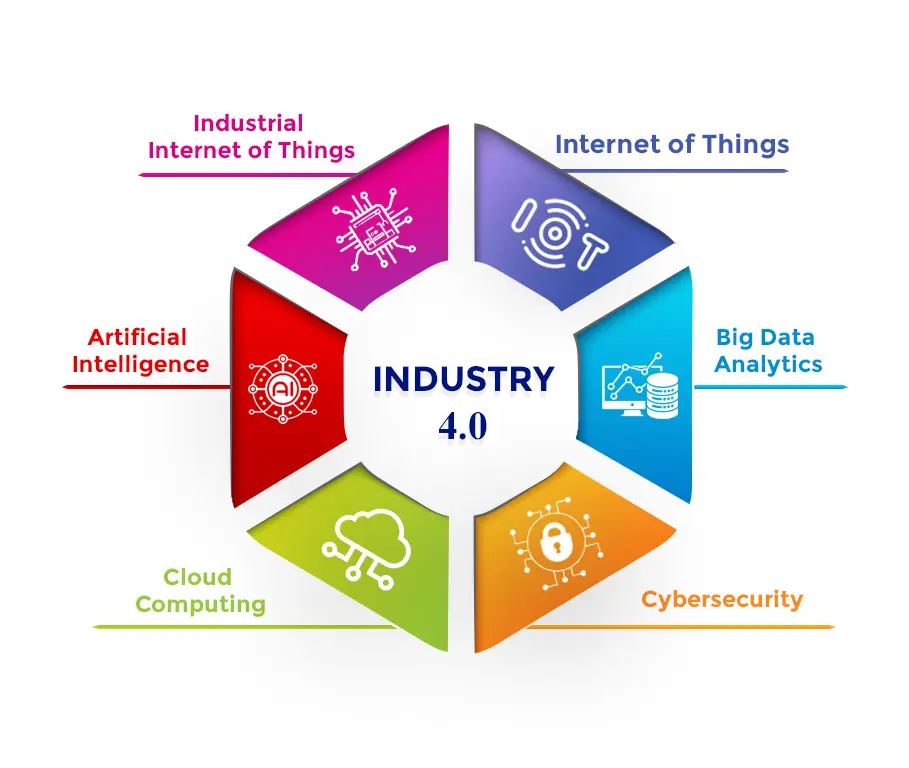
1. Internet of Things
The Internet of Things (IoT) indicates the fast growth of a network of connected objects. It can collect data and exchange it after analyzing it through the use of sensors. It has become a significant technology of the twenty-first century. Any physical object can get transformed into an IoT device. It is possible when you connect it to the internet to control and send information. By connecting both the physical as well as the digital world, IoT makes the world smarter.
Smart factory equipment, smart home security systems, and autonomous farming equipment are examples.
2. Industrial Internet of Things
There is an interconnection between a cluster of sensors, instruments, and autonomous devices. Their interconnection is through the internet to industrial applications. It is the Industrial Internet of Things. It is an extension of the Internet of Things.
When compared to IoT, the Industrial Internet of Things is very expensive. Only commercial areas, like industries, make use of it. It consists of sensitive devices and industrial applications. It can raise the level of manufacturing. Some of the industrial internet of things companies are Tesla, Airbus, MAN, Caterpillar, and so on.
3. Artificial Intelligence
Artificial Intelligence is the main element that plays a major role in the development of smart factories. AI makes use of the data to reshape the working ways. It makes effective use of machinery. It aids in recognizing better ways for improvements. Those improvements lead to increased efficiency of the product. It allows machines to think. Also, it tends to help a machine learn and make decisions.
It is useful to tackle difficult issues. The issues include security problems, traffic control, surveillance, etc. Nanotechnology is very useful. This technology is useful in performing important cancer surgery. Smart classrooms are going to replace normal classrooms. There is a high chance of including Artificial Intelligence (AI) and Machine Learning (ML) in the syllabus. It is because the study of these technologies is necessary for the future generation.
4. Big Data Analytics
Big data analytics is another salient part of Industry 4.0. Its purpose is to accumulate information and data from consumers. It allows the manufacturers to create convenient items and services for the consumers. In today’s digital world, data is crucial to us. Customers can receive timely service and save both money and time. It is possible when there is proper processing of this huge amount of data.
Big data can completely change the governance system. It will be more transparent and efficient. Implementing policies is a major headache for the government. Big data using AI is a solution to overcome this issue. The government can reach out to those in need and there is no chance of excluding any person from justice. In this way, big data will continue to guarantee comprehensive socio-economic development.
5. Cloud Computing
Cloud Computing plays a vital role in Industry 4.0. It helps in preserving and obtaining data. It allows the company to access those obtained data whenever they need it. It occurs over the internet rather than on the hardware of a computer. The most popular social media app ‘Facebook‘ is one of the applications of cloud computing.
6. Cybersecurity
Cybersecurity is necessary to protect internet-connected devices from cyber threats. It is otherwise called Information Technology Security.
There are few key concerns of Industry 4.0. These principles support companies in identifying and implementing industry 4.0 scenarios.
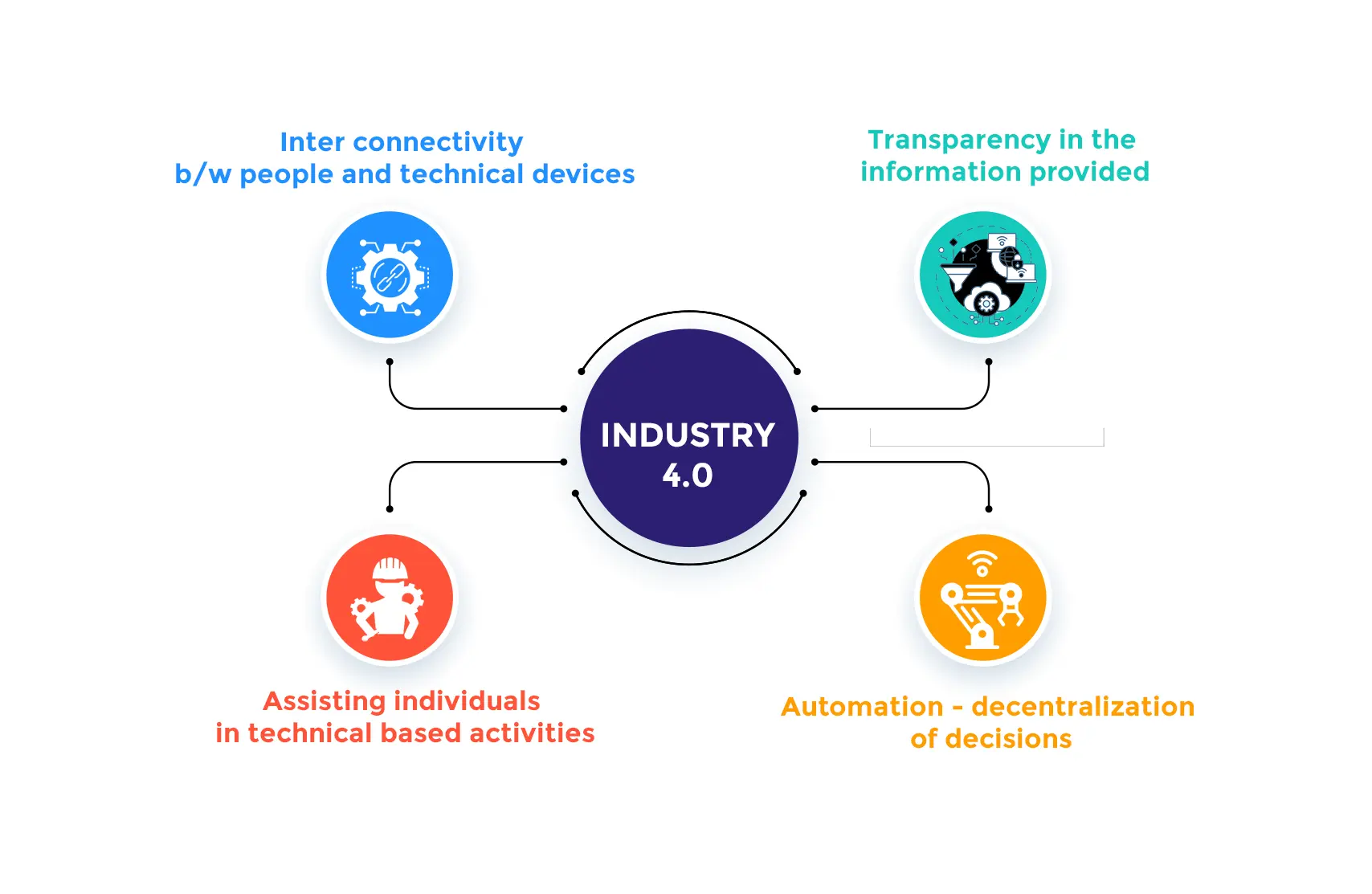
1. Inter-Connectivity
By inter-connectivity, people and technical devices procure the ability to connect. They also communicate with each other through the Internet. Industry 4.0 has a concern for inter connectivity. Because it is the foremost step towards digitization of the process of production.
Inter-connectivity permits business people to understand the process of production. It is possible to collect data on different aspects of the use of machinery. This data collection is for the sake of preventive maintenance.
2. Transparency in the information provided
Information transparency helps the management to track the process. It also helps to optimize the higher efficiency products. Transparency provides plenty of helpful information to the operators. Such information helps them to make wise decisions. It also allows gathering a lot of information about the manufacturing process. This in turn helps to identify the area which needs further improvements
3. Assisting individuals in the technical based activities
Industry 4.0 technologies don’t allow human beings to solve problems on their own. The technologies of Industry 4.0 put an end to the role of human beings as machine operators. It made them decision-makers and problem solvers. They designed help systems. Its function is to assist the operators in decision-making to solve an immediate problem.
4. Automation
Cyber-physical systems meet the ability to decide on their own. It is possible only when the whole process is under remote control. It also performs its functions without the help of man. The focus of automation is to increase flexibility, improving the process of manufacturing. It also focuses on upgrading the quality of the product. Its main focus is to bring down the errors in the manufacturing processes.
There are some hurdles in the implementation of Industry 4.0. Few of them are as follows:
1. Digital skill deficit
Technical and Digital literacy is crucial for the employees to work. They must own the ability to handle all the manufacturing processes. They must also possess the capacity to handle all the digital tools. Without this ability, it is impossible to take the business to the level of success. The technologies of Industry 4.0 seems to be very much advanced. The insufficient digital knowledge in an employee can make him feel some sort of difficulty in working in a factory which is fully digitized.
2. Privacy protection for data
All the interconnected devices connect and communicate with each other. It is possible only through the Internet. Those devices are always at risk of a cyber attack by hackers. Hacking is possible in the absence of proper cyber security measures.
3. An expensive initial investment
Industry 4.0 is drawn upon the Internet of Things network systems which connect all the entities to gather the data. The setting up of IoT network systems requires a high amount. So it becomes a challenge for the implementation of Industry 4.0.
4. Solutions to overwhelm those hurdles
Industry 4.0 has generated new changes in the business world as well as the human world. Some changes are as follows:
1. Remolded the way of manufacturing
Industry 4.0 technology help to shift the way of manufacturing. That is, from the traditional method to the digital method. Before the fourth industrial revolution, every work was manual. But after its arrival, automation rules every process of manufacturing.
It has given the manufacturers a platform to create digital twins. Digital twins are the virtual model of processes, supply chains, and production lines. Manufacturers are using those new technologies throughout the process of production.
2. Productivity level changed from low to high
With the help of Industry 4.0 technologies, manufacturers have improved the quality of their products. There is also improvement in the efficiency of their products. These technologies play a vital role in self-optimization and increase automation. There is proper maintenance of the devices through these technologies. As a result of this, the rate of productivity level is lifted from low to high.
3. Transmuted the factory into 'smart' factory
Industry 4.0 technologies have generated smart factory which involves automation of processes. It needs no help from human beings. The smart factory becomes mechanized. It allows manufacturers to gain profit by reducing errors. By improving the quality of production, manufacturers can gain profit. High accuracy and efficiency in the manufacturing process can bring profit. Industry 4.0 has made the factory to be aware. Factories became intelligent to foretell and maintain operational performance.
Further, it also made the factory own the ability to control its process of production. And also to manage the process of manufacturing.
4. Optimizing the process of manufacture
Industry 4.0 technologies promote automation. The manufacturing process becomes more flexible. It is responsive to the customers by the use of Industry 4.0 technologies. Industry 4.0 has created a smart factory where all advanced technologies combine to work together. It is to optimize the process of manufacturing. The manufacturing process is under the control of a decentralized system. But it functions as a single entity.
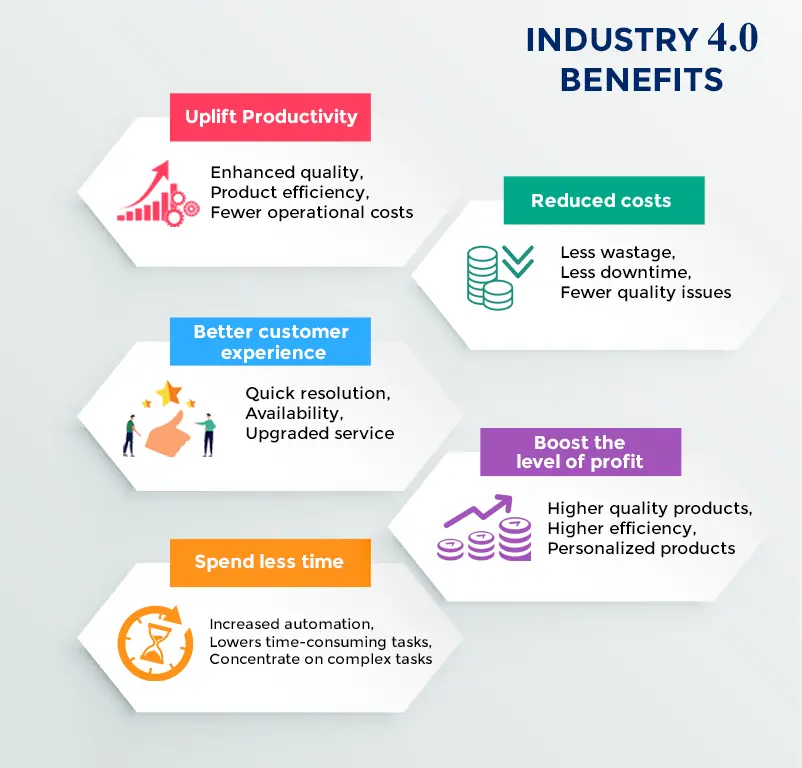
1. Uplift Productivity
As there is improvement in the quality and efficiency of the product by using new industry 4.0 technologies, productivity rate will increase as a result of it. The rate of production is also increased by fewer operational costs.
2. Reduced Costs
Though Industry 4.0 requires a high amount to invest at the time of setting up, we can achieve reduction of cost through several things. They are : Less wastage, less downtime, and fewer quality issues. Efficient use of all resources also helps you to see a large reduction in cost.
3. Better Customer Experience
Technologies of Industry 4.0 helps to upgrade the service you put forward to your customer. This enhances the customer experience.
4. Boost the level of profit
Industry 4.0 technologies enables us to produce innovative products with higher quality. Through these technologies it is possible to produce customer personalized products. Better customer experience will also uplift the level of profit. Higher efficiency of the product boosts the profitability.
5. Reduce time spent
With increased automation, our time will be freed up for concentrating on more complex tasks. By lowering the amount of time-consuming, rule-based tasks that are required to manage the company, personnel in all disciplines can gain from automation in their everyday work life. Reducing the time spent on repetitive tasks is one of the most important potential that automation offers.
1. Japan
The year 2008 marked the advent of adopting new technologies in Japan. When considered globally, the manufacturing sector of Japan holds the third position. The utilization of AI, IoT, and 5G technologies enables the non-face-to-face functioning in manufacturing factories. It is evident that, in Japan, there was a profound growth of competent human resources. The era led by industry 4.0 marked the development of new industries like robotics, and AI in Japan. So it is the era of intense advancements.
2. Germany
It is the government of Germany that first coined the term Industry 4.0 in its high-tech strategic action plan. The impetus behind the German government’s fourth industrial revolution is to provide an organized policy framework. It is to safeguard Germany’s industrial competitiveness. Germany is one of the forerunners of the fourth industrial revolution. The purpose of Industry 4.0 is to facilitate changes in the digital structure and its framework conditions. As a step for the promotion of the project industry 4.0, the establishment of ‘Platform Industrie 4.0’ took place in Germany. In order to serve Industry 4.0, the German government focuses on its Research and Development (R & D).
3. USA
The Advanced Manufacturing Partnership (AMP) program is an attempt by the US Government to tweak the quality of the product. It is also an attempt to enhance the competitiveness of American products on a global scale. The White House announced the Advanced Manufacturing Cooperation Program 2.0. Its aim is to boost advanced American manufacturing. The U.S government employed a triumphant strategy in the accomplishment of Industry 4.0. It is to invest heavily in training new technologies and skills to fill the trade deficit. It is also to take into account the total cost of procurement and location decisions for companies.
4. Canada
Canadian manufacturers hold a unique position, when compared globally, in adopting the digital transformation. There are two major challenges involved in the implementation of Industry 4.0. They are: building a digital culture and also a workforce with necessary technical skills. Canada has a large number of highly skilled employees. it includes software engineers, computer scientists, and data scientists. These employees can quickly expand their use of digital technology to improve their business.
India and Industry 4.0
India’s Industry 4.0 program aims to make use of the technology to manufacture products for the global market at competitive prices. There are some objectives for the implementation of Industry 4.0 in India. They are : to promote the level of innovation; enhancing the skills; construction of world-class infrastructure
The Government of India craves for both the national and international investors to manufacture products in India. This in turn will make India the manufacturing hub of the planet. The intention of India is to assimilate advanced technologies into manufacturing initiatives, smart cities and infrastructures. The aim also entails the latest notions into manufacturing and business as a part of the national initiative called “Digital India“.
The fourth industrial revolution has an impact on all sectors in India. This includes villages and also large cities. Big data and Artificial Intelligence forms the base for Industry 4.0 in India.
By making use of all those advanced technologies, we can lead our life and business at ease.
Industry 4.0 - Adoption in Indian Sectors
India is very interested in adopting Industry 4.0 and is taking some initiatives. Many Indian sectors have adopted Industry 4.0 technologies in their work.
Some steps to make the process of adopting industry 4.0 faster in India are as follows:
In India, there is a huge middle and working class. They could sustain consumer-led growth over a few decades. This is an opportunity for India in the fourth industrial revolution. Due to a less dependent economy, there is a lowering in India’s tax rates. This could make India an attractive option for foreign investment. The government has already started the 'Make in India' project. This project aims to modernize the design and manufacturing process of the manufacturing industry.
To meet the requirements of the Fourth Industrial Revolution (4IR) is also its aim. Government smart city projects can enable all devices to connect over the network. Then it can provide services in an automated manner in the event of a revolution in the Internet of Things. Cities selected for this project can be able to distribute across the country. Some of the sectors that adopted Industry 4.0 are as follows:
Besides the already executed steps, some other steps are also needed for the change.
Role of Government in adopting Industry 4.0 in India
“SAMARTH Udyog Bharat 4.0” stands for ‘Smart Advanced Manufacturing And Rapid Transformation Hub’. It serves as an initiative for the implementation of Industry 4.0 in India. ‘National Manufacturing Policy (NMP) supports this program.
NMP aims to upgrade the share of fabricating up to 25%. It is to make everyone realize that we can only move forward with Industry 4.0. SAMARTH aims to make the manufacturing companies aware of Industry 4.0. The mission of SAMARTH is to bridge the gap that lies between the products of India and foreign countries.
There are also other initiatives taken by the Government of India to adopt Industry 4.0 in an effective manner. It includes the Indian National Program on Artificial Intelligence, administered by NITI Aayog and the Mission for Cyber-Physical Systems.
The government of Andhra Pradesh plans to develop 10 IoT hubs in the state. It is through collaboration with the private sector. Indian companies are partnering with software companies. It is to develop new solutions for IoT and machine-to-machine.
Steps to be further taken to adopt Industry 4.0 in India
Sensors and devices bring about a large number of data. Companies need to organize this data and extract meaningful information. It is important to integrate IT into the existing OT infrastructure in the plant. So that everyone involved can access the data. You need to be able to run AI models. They can predict trends and perform causal analysis to improve human decision-making. There is an urgent need to develop human resources at the factory. Investment to build analytics and digital technology capabilities by the companies is essential.
Governments and industries need to work together to create a workforce for Industry 4.0. Using new technologies throughout the value chain is essential. The systems need to be comprehensive and network-wide. One of the big problems in the manufacturing industry is getting used to working in silos. A lot of effort is evident from both the enterprise and departmental levels. But with these actions, meaningful achievements are not possible. So there is a need to develop metrics company-wide to track the progress.
Retail Sector
Retail and Consumer (R & C) goods companies are going through a transition that they have never experienced before. They have experienced disruptions and intense competition in the past. But at present, it is best described by profound shifts in technology. The shift includes the taste of the customer, marketing tactics, supply chain, sales channels, entry hurdles, and logistics plan.
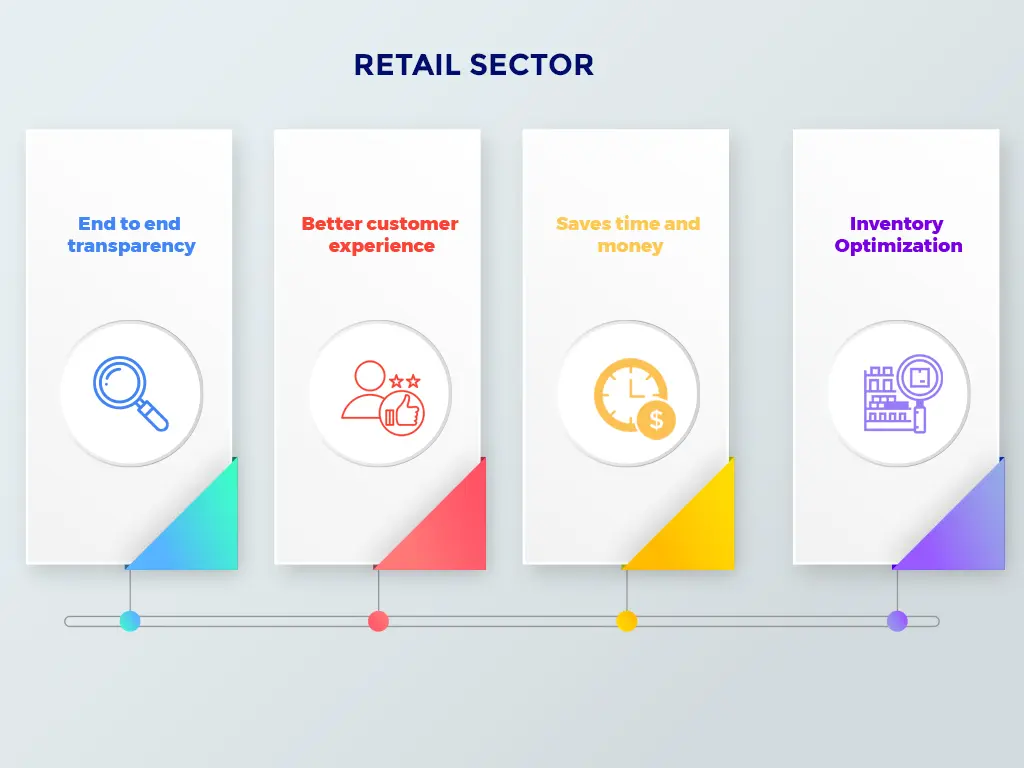
Industry 4.0 serves as an umbrella that covers all these things. When navigating into a new environment, R & C companies must be ready to take a series of steps. Retail and consumer products organizations have been largely focusing on digitizing their customer interface in recent years. The end-to-end supply chain’s digital integration is now a strategic priority.
This entails digitizing the availability of goods and services; the creation of groundbreaking digital business models, digitizing and integrating supply chains; embracement of data and analytics. These all function as key competencies. The one and only aspect of implementation is designing a new strategy. Frequent review and updating of management techniques, company culture, innovation engines, and the role of Information Technology are crucial.
After the adoption of Industry 4.0, we can see significant changes for retailers and consumer products corporations. It is because of the advent of advanced technologies. These technologies encompass the instigation of the warehouse, credit cards, back-office automation, and supply chains.
In the case of R &C companies, there is an expectation that Industry 4.0 have a somewhat bigger influence over it. These companies must start embracing the widening modernization and interrelatedness of products, marketing strategies, and suppliers. Doing so will enable them to be flexible and responsive to consumer demands and boost profits. This is requisite as the demands of the customers are fluctuating.
Industry 4.0 helps in the removal of data barriers. As a result, industries are rapidly becoming a way to drive data-driven decision-making and improve overall profitability and competitiveness. The term 'Retail 4.0' has come to describe a number of trends and developments that are impacting the global retail sector. This concept is commonly called ‘Intelligent digital’. It promotes innovation in customer experiences. It reconsiders the role of the store in merchant-customer relationships.
It makes use of advanced technologies such as the Internet of Things (IoT), artificial intelligence, and cloud computing. The result is machine efficiency and decentralized optimization. As smart retail is already in use, it has a significant impact on both the workforce and vendee.
THE ROLE INDUSTRY 4.0 PLAYS IN BENEFITTING THE RETAIL SECTOR :
2. Automobile Sector
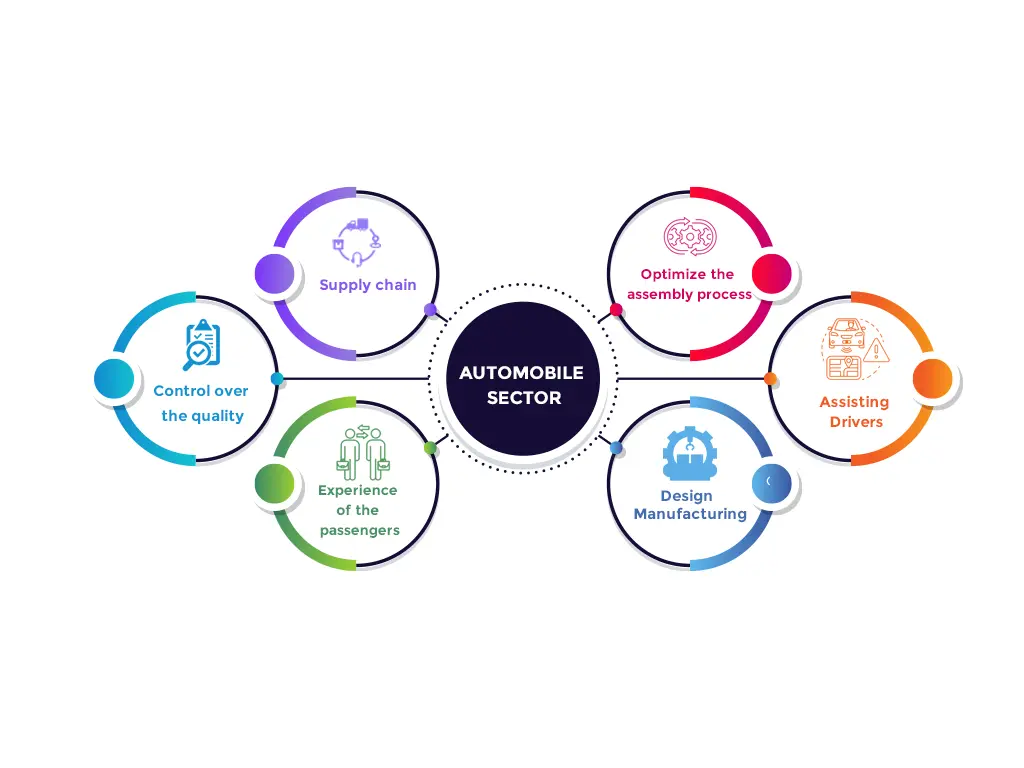
With the advent of Industry 4.0, the automobile industry is experiencing some ground-breaking innovations. It subsumes a seamless transition from powerful, fuel-efficient vehicles to the impending battery-powered vehicles. Included in this astounding growth is additive manufacturing. It is also known as 3D printing.
Modern additive manufacturing techniques enable professionals to concentrate on and rationalize intricate designs and rapid demonstrations. This would otherwise be challenging to do with conventional manufacturing techniques. The automobile industry now has access to designs. The ability to create is also attained. The newly discovered technology, which also improves the supply chain, made it possible. Further, this enables testing, manufacturing, and managing. Assembling automobile parts and components in an effective, optimal, and economical manner is also enabled.
Automakers want to be more efficient. Therefore, it seems best to adopt Industry 4.0 practices. Using AR images or technical information from vehicle parts helps to optimize the assembly process, make operations cost-effective through prototyping, and reduce design costs. In addition, AR-based storage location awareness, automated processes for storing parts, and product development increase productivity.
High manufacturing demand requires the implementation of digital twins, automation, programmable bots, and predictive analytics. The practice of Industry 4.0 is agile and easy to configure with minimal human intervention. With the dawn of Industry 4.0, the processes and procedures of the automotive industry have become more flexible.
3. Agricultural Sector
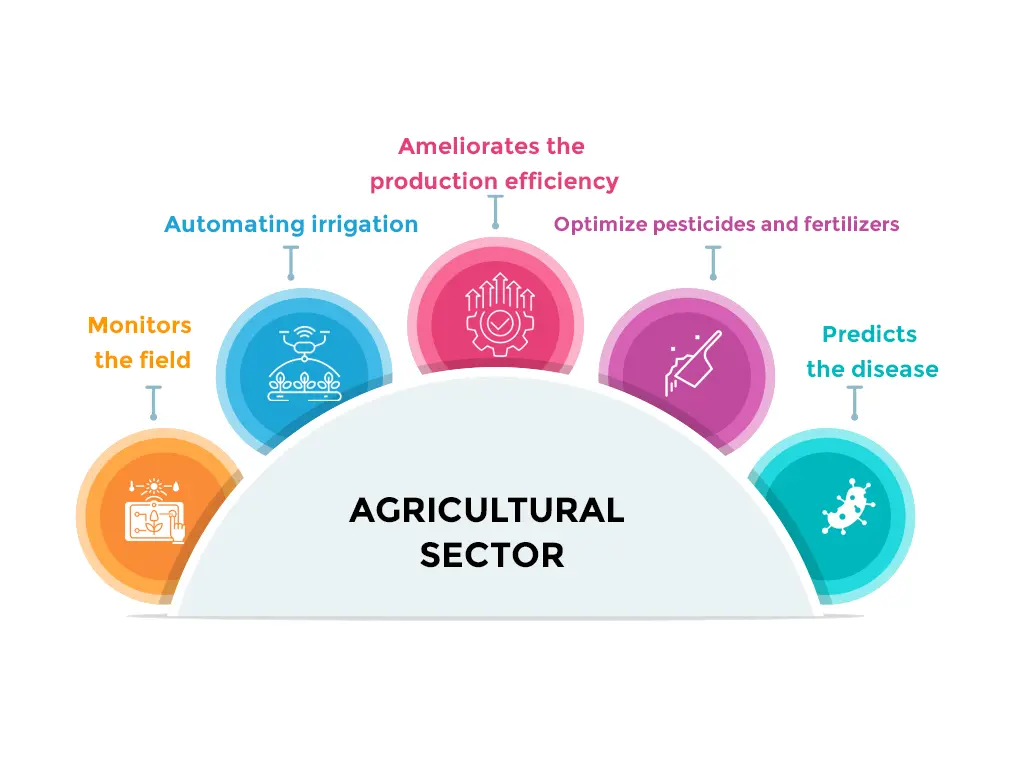
M.S. Swaminathan is an Indian Agricultural Scientist. His adage, “Agriculture is the backbone of the livelihood security system of nearly 700 million people in our country”, is veracious. It is because greater number of people in India is contingent on farming and related work. The remuneration gained from agriculture plays a major role in the revenue of the country.
Industry 4.0 imprinted its footprints in assorted sectors which entails agricultural sector also. There are numerous methods to apply modern technologies in agriculture. In order to get relevant data, we can apply these advanced techniques. This enables analyzation for better resource utilization. On the other hand, using new technologies can also lead to more automation and efficiency while carrying out operations in crops.
Big data will have a bigger impact on the agricultural sectors. It has the ability to help the entire supply chain. Up and down the supply chain, the advanced accessibility of a global agriculture network offers numerous advantages. Farmers can use their data to implement the appropriate products, at the right rates, and at the perfect time. Vendors can use data to source inputs and place themselves for the best possible advantage in the market. Manufacturers can enhance their production processes and more effectively target their customer bases. Big data will boost the chain’s overall profitability and competitiveness.
It is feasible to automate the performance of various maintenance activities in the fields or to monitor the state of the crops by using sensors and taking the appropriate actions. Robotic arms or autonomous vehicles helps in achieving it. One potential use of Robotics, for instance, would be to automate vine pruning.
There are numerous benefits of integrating new technologies into the agricultural sector, including:
4. Healthcare Sector
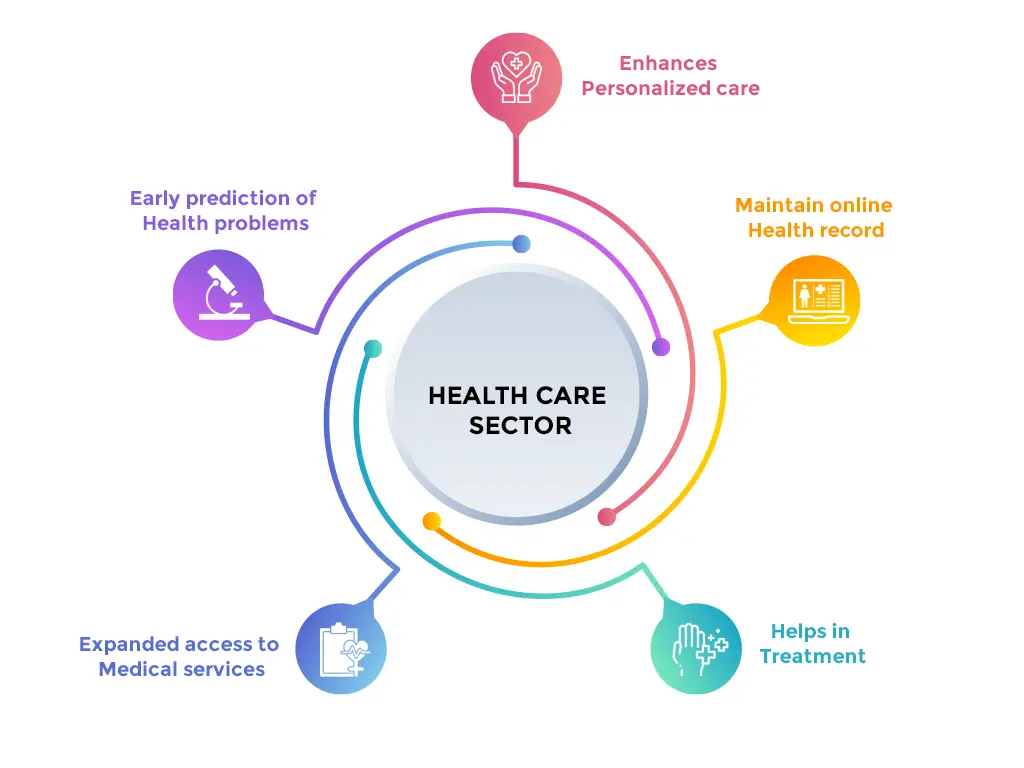
The Fourth Industrial Revolution is altering the way we understand health, the way we treat and diagnose, the relationship between health care professionals and patients, and the way we manage and organize our health care system. Over the past century, Industry 4.0 in healthcare has undergone a significant evolution. In reality, it is always changing, with researchers and medical professionals alike developing new tools and techniques. With the development of cloud computing and big data, health care and technology have become entangled.
The goal is to provide patients with better, more value-added and more cost-effective medical services while improving the effectiveness and efficiency of the industry. The Internet of Health Things, Medical Cyber-Physical Systems, Health Cloud, Health Fog, Big Data Analytics, Machine Learning, Blockchain, and Intelligent Algorithms are all used after integration.
A telemedicine system for remote patient monitoring allows doctors to remotely check the patient’s health. It is also known as “home tele-health” and “tele-monitoring”. Telemedicine providers are beginning to offer software and solutions. It is helpful to record patient medical records with the advent of wearable technology and mobile medical devices. As well as it connects patients and doctors.
Real-time tele-health includes live two-way video calls between the doctor and the patient. It is also known as “Synchronous tele-health”. It can partially replace the direct visit between the doctor and the patient.
Advances in digital health care technologies are changing the future of health care at hand. Those technologies include artificial intelligence, virtual reality, 3D printing, robotics, and nanotechnology. Organizations keep up with new technology trends and work with technologies that will shape the future of health care.
5. Hospitality Sector
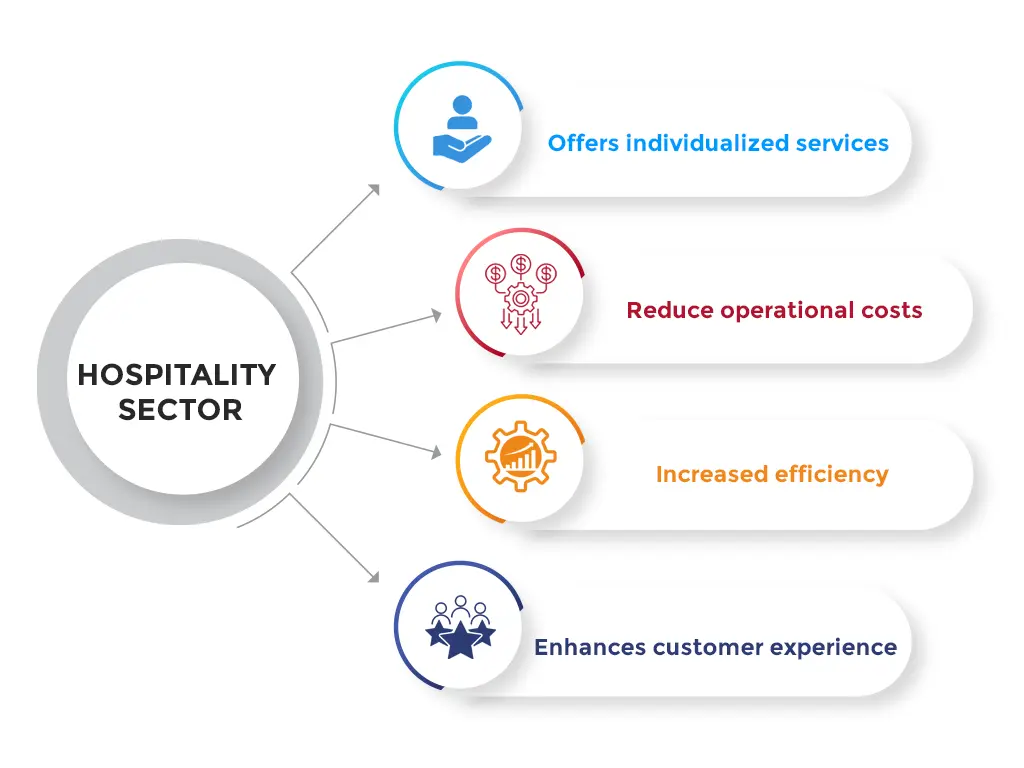
Industry 4.0 sojourn well-nigh all sectors which subsumes the hospitality industry also. The goal of Hospitality 4.0 is to create more personalized and digitized services for consumers. This helps them to solve problems related to popularization, personal experience and sustainability. To create unique, personalized experiences in a more cost-effective way, AI and robots play a crucial role.
There is an interoperable and connected system that facilitates information sharing. It will generate value for the entire community of stakeholders via digital platform. “Smart Hospitality” is the name given to it. It offers customized and contextualized services as well as experiences to the clients. As a result, smart hospitality will put clients at the centre of the business and enable information flows along the supply chain. The utilization of hospitality services by consumers has altered as a result of the new technology. Consumers are now able to partake in a variety of activities. Hospitality must adapt to new technologies to meet the demands of the customers as they expect a lot.
Augmented Reality (AR) combines real and virtual items in a real environment. It synchronizes real and virtual objects, and allows for real time, three-dimensional interaction. It is a pillar of hospitality 4.0. In recent years, AR has given travelers and hospitality companies various opportunities. Tourists can communicate and exchange information and ideas with other travelers. It takes place via big networks. It offers more individualized services and other advantages like navigation of certain areas.
The hospitality sector collects and produces enormous amounts of data about the preferences and traits of consumers. Big data in the hotel industry encompasses both internal big data stored in centralized databases and external big data gathered via sensors from the Internet. Categorization of the data happens according to their types and features. Participants in the hospitality ecosystem can access and use this data to create strategic business plans and dynamically manage their operations. To provide individualized services, the hospitality sector needs to comprehend tourist tastes, behaviors, and locations. This entails the appropriate collection, storing, and use of data as well as their protection against dangers. There is an improvement in the security and connectivity of tourism networks with the hospitality sector.
6. Home Automation
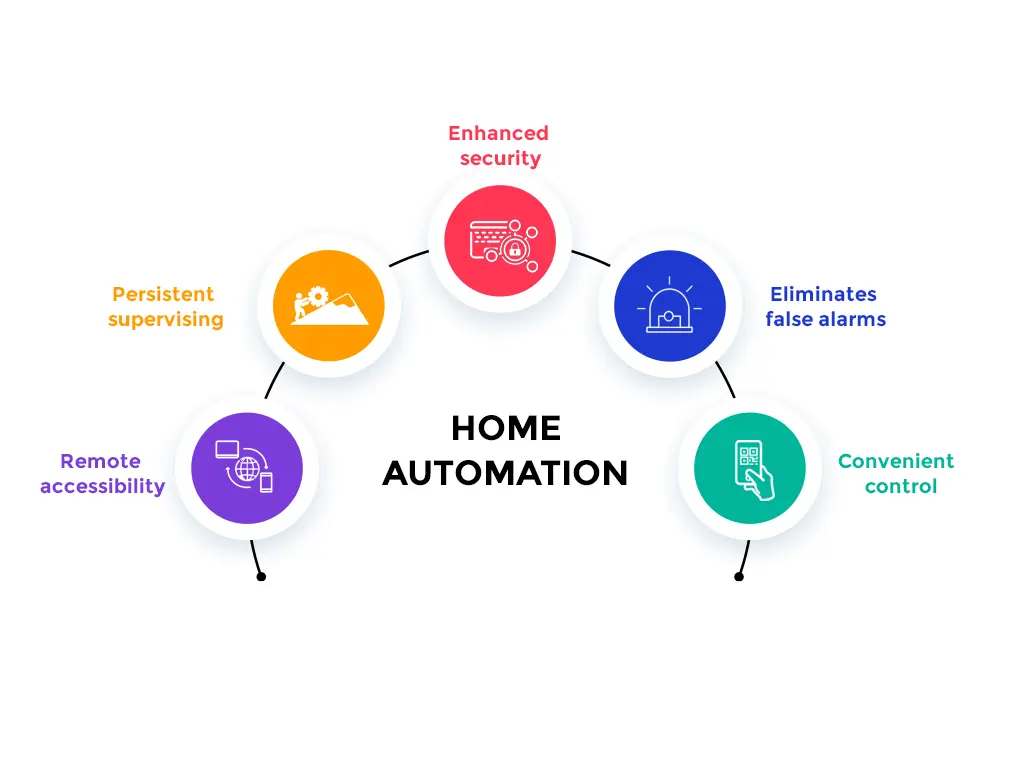
Home security system has become more effective after the emergence of advanced technologies. The adoption of smart homes is the driving force for the rising demands for smart home security systems. Smart security system is an integral part of smart home. The advanced technologies that rise during Industry 4.0, like IoT, paves the way for smart homes.
Technology improvements have made it possible for video surveillance camera quality, recording capacity, and more critically affordability to advance while reducing prices. It is the main driving force behind the security camera. All security systems are built around security cameras. The IP camera, often known as a network or internet camera, is one of the most widely used types of video cameras. It offers live video and audio clips that the user may view anywhere by using an internet browser. However, because of their adaptability, agility, and usability, wireless security cameras have become more and more popular. They are simple to install. It is because they don’t need long and expensive wires or professionals to set them up.
The sector of home security and monitoring has the potential to benefit significantly from Artificial Intelligence (AI). Additionally, Artificial Intelligence and Machine Learning could decrease the likelihood of false alarms. It improves the efficacy of video analytics in detecting aberrant activity. It further provides higher resolution confirmation and surveillance competence. More customers may become interested in security and monitoring systems after the advent of this combination.
7. Energy Sector
Industry 4.0 makes contributions related to the energy sector. It is a revolution that continuously transforms the energy sector as technology advances. Industry 4.0 is pivotal to the transformation in the energy sector. The new technologies will allow the sector to equip existing systems with the necessary tools. For instance, data acquisition sensors. It equips the systems also with various elements which facilitate process optimization.
Meanwhile, the introduction of information technologies such as big data and artificial intelligence will enable the development of sustainable and efficient models for energy consumption and production. This opens up a world of unprecedented possibilities in energy management, enabling real time prevention and correction of inefficiencies and decision-making based on predictive mathematical models.
The electricity sector attains the following benefits because of Industry 4.0 technologies.
Industry 4.0 makes production processes and services more responsive to consumer needs. It also makes factories, goods, and supply networks smarter as well. At present, many technology companies are trying to sell their products under the umbrella of Industry 4.0. Industry 4.0 concepts will evolve further, based on market dynamics in the future.
We are with all ears waiting to hear from you. Post us with your questions and feedback.